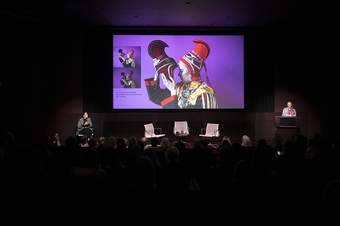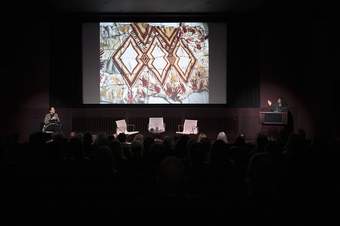In Outi Pieski’s installation Guržot ja guovssat/Spell on You! 2020, central to the artist’s solo exhibition at Tate St Ives, colourful threads hang together in conversation – the artist’s visualisation of women communing in the landscape. Surrounding them are black-threaded chevrons that dart through the space like birds. During the First Nations Australian political movement calling for equal rights and self-determination in the 1930s, campaigner Douglas Nicholls famously pronounced: ‘We do not want chickenfeed… We are not chickens; we are eagles’. This assertion of Indigenous freedom from colonial oppressions, both historic and contemporary, highlights the importance of land, and how non-human beings are appropriated as national symbols or representatives of our environmental and cosmological relationships.
Nicholls’s proclamation also connects with First Nations artists across cultures; as here at Tate Modern, in a talk between contemporary practitioners Outi Pieski (Sámi peoples, Sápmi Lands, Finland) and Maree Clarke (Boon Wurrung, Mutti Mutti, Wamba Wamba, Yorta Yorta First Nations peoples, Australia). The chair, Tate curator Kimberley Moulton, picked up on themes raised in ‘Indigenous Visions’, a forum convened by Professor Brook Andrew during the Venice Biennale 2024, in which Moulton was a participant.1 Andrew, an Australian artist and curator, was also an advisor for the first Sámi Pavilion at the 59th Biennale in 2022, tote bags from which Pieski and her family members wore proudly to the event, highlighting these transnational solidarities.

Left to right: Sumayya Si-Tayeb, Outi Pieski. © Tate, Kathleen Arundell 2024
While rooted in Moulton’s particular expertise and focus on Australia, the talks started with Pieski, before returning to the region of south-east Australia with the work of Maree Clarke. Pieski’s self-described practice of ‘radical softness’ manifests in an engagement with materials through large-scale installations of Sámi shawl tassels – embodiments of women’s agency and sexuality. The artist talked about Skábmavuođđu – Spell on Me! 2024, a similar installation and response to the aforementioned earlier work, during their pre-exhibition residency at Porthmeor Studios in Cornwall in January 2024. Within her interdisciplinary practice, she perceives these textile installations as 3D paintings; for the artist, they are ‘forests through which to walk’ – perhaps more dispersed, lightly coloured companions to works by Magdalena Abakanowicz, recently on display at Tate Modern.2
Pieski went on to explain duodji, an Indigenous craft practice marginalised during the Scandinavian colonisation of Sápmi (including the Nazi German occupation of Finland), the region in which the Indigenous Sámi live which is now divided between the nation states of Norway, Sweden, Finland and Russia. Duodji is a holistic concept that might be translated as art, craft or homecraft, though many, like scholar Liisa-Rávná Finbog, strongly resist translation as another tool of limitation.3 These categories neglect duodji’s practical and aesthetic functions, and how it is an ‘active, living process that also respects tradition’, according to the artist.
Translation can further alienate or separate a craft from its original context, much like objects themselves, often displaced in Western/European ‘world’ museums. Pieski showed elements of her collaborative project with Finnish archaeologist Eeva-Kristiina Nylander to document ládjogahpir, the horned headwear of Sámi women, sixty examples of which are held in various European museum collections. Challenging conventions of art and museum object display, Pieski sometimes shows items alongside natural materials like stone and fluff, perhaps drawn from the artist’s local environment, giving a sense of the object having been relocated and displaced.
Maree Clarke, a multidisciplinary artist, shares in Pieski’s activist approach to collections, including of contemporary art. In 1996, Clarke initiated, co-coordinated and co-curated We Iri We Homeborn, the Aboriginal and Torres Strait Islander Arts Festival, including five exhibitions in south-east Australia. The event prompted the National Gallery of Victoria (NGV), Melbourne, to start collecting Aboriginal art. It all began with Clarke driving around in a van, collecting the works from communities.
Clarke’s research into displaced objects has also led her to European museum collections, including sites in Saffron Walden and the Pitt Rivers Museum in Oxford. During the talk, she also described her recent residency in Florence, where she plans to return to intervene in the museum’s conventional display of objects in glass cases and vitrines – another colonial approach to preservation which detaches objects from their context and, according to the artist, ‘deadens’ living things.

Left to right: Sumayya Si-Tayeb, Maree Clarke. © Tate, Kathleen Arundell 2024
Although delivered separately, in succession, the overlaps in Pieski and Clarke’s practices were apparent in their talks. Based in Naarm (Melbourne, Australia), Clarke also has a contemporary connection with Tate, coming from the same family and language groups as Moulton, and who curated a major show of Clarke's in 2011 titled Ritual and Ceremony at the Melbourne Museum. Elsewhere, Clarke has spoken of her British heritages,4 which she can trace to Dunstable in England, and Tipperary in Ireland – two places she believes have informed her practices too.
Both artists agree that land affects positionality; both prefer to work from home rather than conventional studios; and both have practices rooted in the land around their home areas. Walking, driving and skiing serve as sources of inspiration, while Clarke draws from the natural landscape more literally. Her found objects are mainly bodily and animal – ‘mainly roadkill’, she says. She is matter of fact about their collection and explains in great detail how she uses feathers plucked from dead birds, echidna quills gathered by ‘boiling up’ the spiny anteaters and kangaroo teeth, pulled out of dead skulls. Through this, we understand the labour of these practices.
Clarke’s talk did not touch on the commodification of traditional practices, instead focusing on her love for collaborating with her family and community. She shares contemporary photographs of children in Simpsons t-shirts gathering seeds and reeds from the local environment. Elsewhere, Pieski takes photographs of children and young women wearing ‘traditional’ costume while trampolining.5 Both serve as reminders of the temporal othering of Indigenous and First Nations identities, whereby contemporary lived experiences are ignored in favour of a focus on history and tradition.6
For Pieski, ‘craftivism’ is an active means of re-connecting with land. Of mixed heritage, born to a Sámi father and a Finnish mother, she spent her childhood in Helsinki and later moved to her father’s village, Dalvadas, where she ‘had to work on [her] own relationship to [her] home region’.7 Both Pieski and Clarke run workshops in their local community as a means of recovering, re-educating and reproducing histories, where they have long been suppressed. ‘There’s something intuitive about knowledge; that the hands remember, even if the brain doesn’t’, Pieski says.
In the intergenerational transfer of knowledge, Pieski’s work focuses particularly on women. This is captured in her work Rematriation 2020, and in the two-day event that closed her exhibition at Tate St Ives, including a collection of workshops and talks with the local community, schools and Sámi politicians and elders. Clarke shared about her possum skin quilt and cloak-making workshops for the Commonwealth Games in 2006, how she has created museum installations to educate children about the seven seasons, and that she has made her 5,000-image strong photographic collection, the Living Archive of Aboriginal Art, freely accessible online.
Both artists actively resist the representation of their homes as ‘no man’s lands’, referring to empty, unclaimed land often used to justify colonial expansion. Pieski leans into more spiritual, magical depictions, in the deep blues and blacks of works like Deatnu River By The Night 2013 and, more explicitly, in series like Goddesses who live below Linkinjeaggi Marsh 2014. In the talk and the catalogue accompanying the Tate St Ives exhibition she highlights how this spirituality is present in and practiced in everyday life, when picking from fishing nets or pouring coffee on the fire. Challenging the binary separation of human and nature, these practices reflect how we are part of our environments, as well as the Sámi philosophy of soabadit, or positive reciprocity – something necessary to survive in difficult climates and landscapes. Pieski warns against losing relation with the land, for then we would lose the ability and agency to save it.

Left to right: Sumayya Si-Tayeb, Kimberley Moulton, Outi Pieski, Maree Clarke.
© Tate, Kathleen Arundell 2024
Pieski, Clarke and Moulton agree at the close of their conversation that these questions of human and environmental exploitation are pressing in our ‘postcolonial’ time, as both regions face a kind of eco-colonialism from extractive mining businesses and government organisations. At the same time, there is a further marginalisation, in the expectation of local populations to protect their own land; indeed, many of the last remaining biodiversity hotspots in the world are in the Arctic region. They urged for solidarity between the ‘so-called minorities’, reminding us that it would be the majority who suffer by losing sight of and relation to them.
Pieski’s exhibition at Tate St Ives is singular in range and scale, but it is by no means alone. Pieski was previously commissioned by Southbank Centre, London, as part of the Nordic Matters programme in 2017, and her show comes alongside UK and European exhibitions of work by Danish-Greenlandic photographer Pia Arke and Arctic artist Shuvinai Ashoona in 2024. For the first time, the European Capital of Culture is being hosted within the Arctic Circle, on Indigenous land, in Bodø, Nordland County, Norway. There, in June 2024, Tomas Colbengtson will be presented with the Queen Sonja Print Award, the first Sámi artist to receive the world’s most important prize for printmaking.
This panel discussion came just weeks before the Sámi Museum Siida in Finland was awarded European Museum of the Year 2024, and Clarke and Moulton both commented on First Nations artist Archie Moore’s receipt of the Golden Lion for national participation at the 2024 Venice Biennale – the first time an Australian pavilion has won the prize.
The event also follows Tate’s own recent announcement of a new programme to increase the representation of Indigenous artists in its collection,8 and a forthcoming exhibition of work by Emily Kam Kngwarray.9 But much more can be done beyond exhibition and acquisition; elsewhere, Pieski has suggested that there are plenty of Sámi and Indigenous curators, and institutions must employ them as workers, if they own or display Sámi objects.10
Previously, both artists have hinted at the two-part, layered process of this restorative work: Western/European museums can only participate in repatriation, but rematriation must take place within the Sámi communities and domestic institutions.11 Likewise with We Are Eagles, though thought-provoking for the audiences in London, the direct empowerment and impact will come with the second iteration of the talks, in Australia; and, following Clarke’s lead with her online archive, by making recordings of paid, ticketed events free to access online, for more people to watch and learn.
